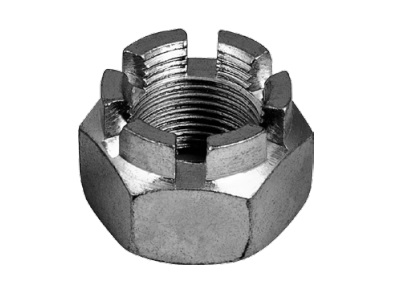Key Features and Uses of Slotted Nuts
2024-05-29
A slotted nut, also known as a castle nut or castellated nut, is a type of nut used in conjunction with a bolt or threaded rod that incorporates slots or notches cut into one end. These slots are designed to accommodate a cotter pin or wire that passes through a hole in the bolt, providing a locking mechanism to prevent the nut from turning and loosening under vibration or torque.
Key Features and Uses of Slotted Nuts
1. Design and Structure
- Slots or Notches: The defining characteristic of a slotted nut is the series of slots cut into one end. These slots align with a hole drilled through the bolt or stud.
- Shape: Typically, slotted nuts are hexagonal for easy installation with standard wrenches.
- Materials: Commonly made from various metals, including steel, stainless steel, and brass, to suit different applications and environments.
2. Locking Mechanism
- Cotter Pin: A cotter pin is inserted through a slot in the nut and a hole in the bolt, then bent to secure the nut in place. This prevents the nut from rotating and becoming loose.
- Safety Wire: In some applications, especially in aviation and motorsports, safety wire is used instead of a cotter pin to provide additional security against vibration.
3. Applications
- Automotive: Widely used in automotive applications for securing components such as wheel bearings, suspensions, and steering mechanisms, where safety and reliability are paramount.
- Aerospace: Utilized in aircraft construction and maintenance to ensure components remain securely fastened under high vibration and stress conditions.
- Machinery: Employed in various types of machinery and equipment where a reliable locking mechanism is required to prevent loosening due to vibration or torque.
- Agricultural Equipment: Used in heavy-duty agricultural machinery to secure critical components.
4. Advantages
- Security: Provides a reliable locking mechanism that prevents the nut from loosening due to vibration or rotational forces.
- Reusability: Can be easily removed and reused by straightening and removing the cotter pin or safety wire.
- Versatility: Suitable for a wide range of applications and environments, including high-stress and high-vibration settings.
5. Installation Process
1. Aligning: Place the slotted nut onto the bolt or threaded rod and tighten it to the required torque specification.
2. Hole Alignment: Continue tightening until one of the slots aligns with the hole drilled through the bolt.
3. Inserting Cotter Pin: Insert a cotter pin through the aligned slot and hole.
4. Securing: Bend the ends of the cotter pin around the nut to secure it in place.
Conclusion
Slotted nuts are essential components in various industries due to their robust locking mechanism and reliability in preventing loosening under vibration and torque. Their design, which includes slots for a cotter pin or safety wire, ensures a secure connection, making them ideal for critical applications in automotive, aerospace, machinery, and agricultural equipment.



